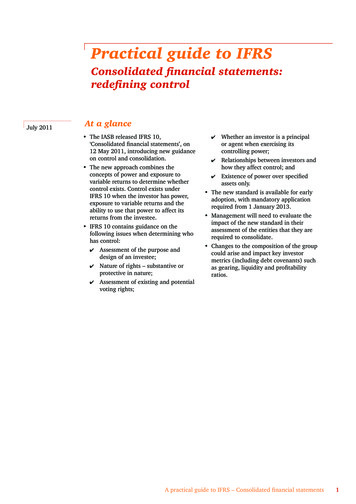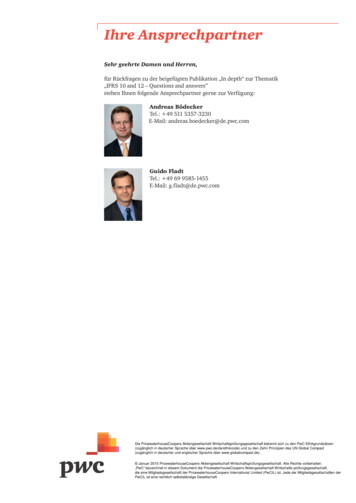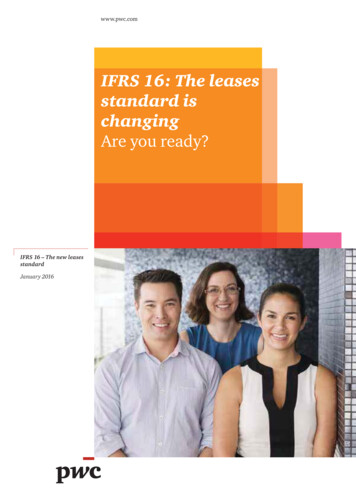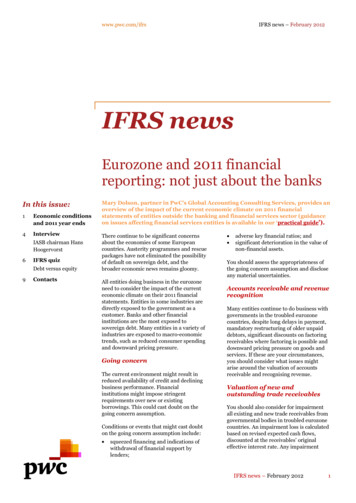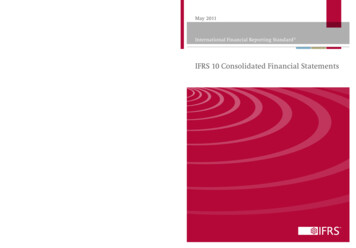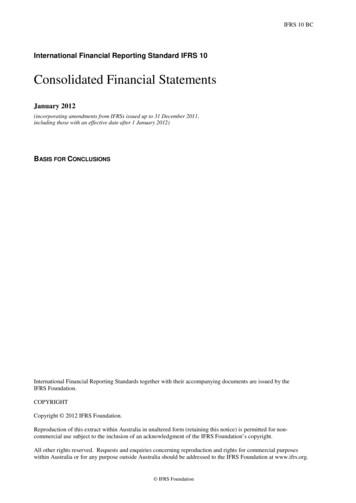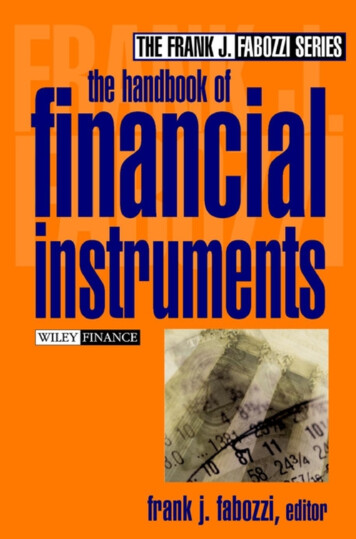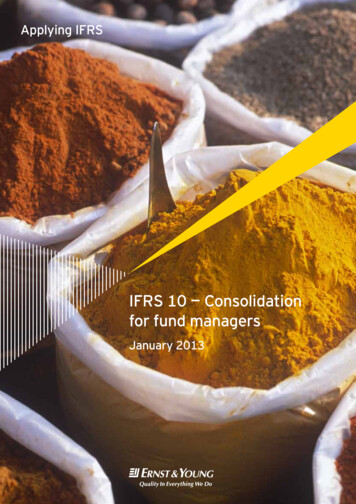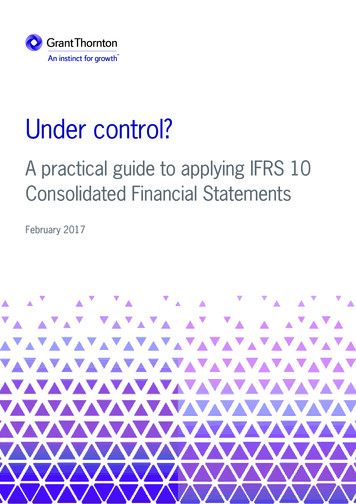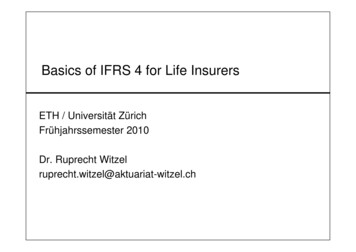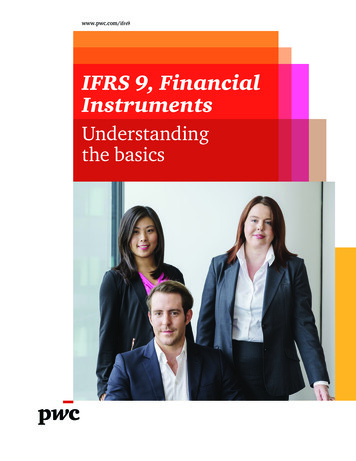
Transcription
www.pwc.com/ifrs9IFRS 9, FinancialInstrumentsUnderstandingthe basics
IntroductionRevenue isn’t the only new IFRS to worry about for 2018—there is IFRS 9,Financial Instruments, to consider as well. Contrary to widespread belief, IFRS9 affects more than just financial institutions. Any entity could have significantchanges to its financial reporting as the result of this standard. That is certainto be the case for those with long-term loans, equity investments, or any nonvanilla financial assets. It might even be the case for those only holding shortterm receivables. It all depends.Possible consequences of IFRS 9 include: M ore income statement volatility. IFRS 9 raises the risk that more assets willhave to be measured at fair value with changes in fair value recognized inprofit and loss as they arise. E arlier recognition of impairment losses on receivables and loans,including trade receivables. Entities will have to start providing for possiblefuture credit losses in the very first reporting period a loan goes on the books– even if it is highly likely that the asset will be fully collectible. S ignificant new disclosure requirements—the more significantly impactedmay need new systems and processes to collect the necessary data.IFRS 9 also includes significant new hedging requirements, which we addressin a separate publication – Practical guide – General hedge accounting.With careful planning, the changes that IFRS 9 introduces might provide agreat opportunity for balance sheet optimization, or enhanced efficiency ofthe reporting process and cost savings. Left too long, they could lead to somenasty surprises. Either way, there’s enough at stake that if you haven’t begunassessing the implications of IFRS 9, now’s the time to start—while you still candeal with its consequences to financial statements, systems, processes, controls,and so on in a measured and thoughtful way.This publication summarizes the more significant changes that IFRS 9introduces (other than hedging), explains the new requirements and providesour observations on their practical implications. If you have any questions,please don’t hesitate to contact your engagement partner or other PwC contact.
IndexOverview .5Classification and measurement . 10The Business Model test . 19The SPPI test.22Impairment .27Interest income .36Presentation and disclosure . 37Effective date and transition.39
OverviewIFRS 9 generally is effective for years beginning on or after January 1, 2018,with earlier adoption permitted. However, in late 2016 the IASB agreed toprovide entities whose predominate activities are insurance related the optionof delaying implementation until 2021.Why the new standard?IFRS 9 responds tocriticisms that IAS39 is too complex,inconsistent with theway entities managetheir businesses andrisks, and defers therecognition of creditlosses on loans andreceivables until toolate in the credit cycle.IFRS 9 replaces IAS 39, Financial Instruments – Recognition and Measurement.It is meant to respond to criticisms that IAS 39 is too complex, inconsistent withthe way entities manage their businesses and risks, and defers the recognition ofcredit losses on loans and receivables until too late in the credit cycle. The IASBhad always intended to reconsider IAS 39, but the financial crisis made this apriority.The IASB developed IFRS 9 in three phases, dealing separately with theclassification and measurement of financial assets, impairment and hedging.Other aspects of IAS 39, such as scope, recognition, and derecognition offinancial assets, have survived with only a few modifications. The IASB releasedupdated versions of IFRS 9 as each phase was completed or amended, and, aseach phase was finished, entities had the opportunity of adopting the updatedversion. The final standard was issued in July, 2014.Comparison to US GAAPThe IFRS 9 project was originally part of the IASB’s and FASB’s jointconvergence initiative. The Boards stopped working on the project exceptfor impairment of loans and receivables because they were unable to reachagreement on certain key matters, and other projects took priority. Ultimately,the Boards did agree on common principles for measuring impairments of loansand receivables, but not on the timing of their recognition. The FASB’s newimpairment standard will be effective for SEC filers for years beginning on orafter December 15, 2019 (with early adoption permitted one year earlier), andone year later for other entities.55IFRSIFRS 99 financialfinancial ding thethe basicsbasics
A summary of the major changesClassification and measurement of financialassets after initial recognitionIFRS 9 replaces IAS 39’s patchwork of arbitrary bright line tests, accommodations,options and abuse prevention measures for the classification and measurementof financial assets after initial recognition with a single model that has fewerexceptions. The new standard is based on the concept that financial assets shouldbe classified and measured at fair value, with changes in fair value recognizedin profit and loss as they arise (“FVPL”), unless restrictive criteria are met forclassifying and measuring the asset at either Amortized Cost or Fair ValueThrough Other Comprehensive Income (“FVOCI”).IFRS 9’s new model for classifying and measuring financial assetsafter initial recognitionLoans and receivables“Basic” loans and receivables where the objective of the entity’sbusiness model for realizing these assets is either: Collecting contractual cash flows; or Both collecting contractual cash flows and selling these assetsAll other loans and receivables.Amortized CostFVOCIFVPLMandatorily redeemable preferred shares and “puttable”instruments(e.g., investments in mutual fund units)FVPLFreestanding derivative financial assets(e.g., purchased options, forwards and swaps with a positive fairvalue at the balance sheet date)FVPLIFRS 9 replacesIAS 39’s patchworkof arbitrarybright line tests,accommodations,options and abuseprevention measureswith a single modelthat has only a fewexceptions.Investments in equity instrumentsEntity irrevocably elects at initial recognition to recognize onlydividend income on a qualifying investment in profit and loss, withno recycling of changes in fair value accumulated in equity throughFVOCIOCI.FVPLOtherNote: FVPL may be used if an asset qualifies for FVOCI or Amortized Cost to avoid anaccounting mismatch.The IFRS 9 model is simpler than IAS 39 but at a price—the added threat ofvolatility in profit and loss. Whereas the default measurement under IAS 39for non‑trading assets is FVOCI, under IFRS 9 it’s FVPL. As shown by the table,this can have major consequences for entities holding instruments other thanplain vanilla loans or receivables, whose business model for realizing financialassets includes selling them, or which have portfolio investments in equityinstruments.The IFRS 9 modelis simpler than IAS39 but at a price—the added threat ofvolatility in profit andloss.Another factor contributing to volatility is the treatment of derivativesembedded in financial assets. Under IAS 39, embedded derivatives not closelyrelated to a non-trading host contract must be measured at FVPL, but the hostcontract often still can be measured at Amortized Cost. Under IFRS 9, the entirecontract will have to be measured at FVPL in all but a few cases.PwC6
Effectively, therefore, changes in the fair value of both the host contract and theembedded derivative now will immediately affect profit and loss.The new model canproduce the samemeasurements asIAS 39, but one can’tpresume that thisnecessarily will be thecase.The fact that the model is simpler than IAS 39 doesn’t necessarily mean that it issimple. For example, determining whether loans and receivables are sufficiently“basic” in their terms to justify measurement at Amortized Cost or FVOCI can bechallenging. To get an appreciation of the complexities that can arise, and theirimplications for classification and measurement, take a quick look at the tableon page 13, Illustrating the application of the Business Model and SPPI tests.The chief takeaway here—the new model can produce the same measurementsas IAS 39, but one can’t presume this necessarily will be the case. The only timeyou can safely assume the classification and measurement of a financial assetalways will be the same as IAS 39 is for freestanding non-hedging derivativefinancial assets which are, and forever will be, at FVPL.Other classification and measurement changesIFRS 9 makes other changes to the IAS 39 requirements for classifying andmeasuring financial assets and liabilities. These include: Allowing trade receivables that don’t have a significant financing componentto be measured at undiscounted invoice price rather than fair value. Eliminating the exemption allowing for measurement of investments incertain non-traded investments in equity instruments and derivatives settledby the delivery of those instruments at cost rather than fair value. Restricting optional FVPL and FVOCI designations. Permitting OCI treatment of changes in the fair value attributable to theissuer’s credit risk for liabilities designated as FVPL. Setting new criteria for reclassifying of financial assets and liabilities.While these other changes to classification and measurement requirements palein significance in comparison to those discussed earlier, nevertheless they canaffect some companies’ financial statements and their implications need to beevaluated.IFRS 9 eliminatesimpairmentassessments forequity instrumentsand establishes anew approach forloans and receivables,an “expected loss”model.77Impairment of financial assetsAccounting for impairments is the second major area of fundamental change: Investments in equity instruments. On the one hand, IFRS 9 eliminatesimpairment assessment requirements for investments in equity instrumentsbecause, as indicated above, they now can only be measured at FVPL orFVOCI without recycling of fair value changes to profit and loss. Loans and receivables, including short-term trade receivables. On theother hand, IFRS 9 establishes a new approach for loans and receivables,including trade receivables—an “expected loss” model that focuses on therisk that a loan will default rather than whether a loss has been incurred.IFRSIFRS 99 financialfinancial ding thethe basicsbasics
Expected credit lossesUnder the “expected credit loss” model, an entity calculates the allowance forcredit losses by considering on a discounted basis the cash shortfalls it wouldincur in various default scenarios for prescribed future periods and multiplyingthe shortfalls by the probability of each scenario occurring. The allowance is thesum of these probability weighted outcomes. Because every loan and receivablecarries with it some risk of default, every such asset has an expected lossattached to it—from the moment of its origination or acquisition.The phrase “expected credit loss” to describe the new impairment model can beconfusing. Because expected credit losses represent possible outcomes weightedby the probability of their occurrence, these amounts are not necessarily“expected” nor “losses”, at least as those terms are generally understood. Ineffect, they represent measures of an asset’s credit risk.IFRS 9 establishes not one, but three separate approaches for measuring andrecognizing expected credit losses:Expected credit lossesare not necessarily“expected” nor“losses”, at leastas those termsare commonlyunderstood. A general approach that applies to all loans and receivables not eligible forthe other approaches; A simplified approach that is required for certain trade receivables and socalled “IFRS 15 contract assets” and otherwise optional for these assets andlease receivables. A “credit adjusted approach” that applies to loans that are credit impairedat initial recognition (e.g., loans acquired at a deep discount due to theircredit risk).A distinguishing factor among the approaches is whether the allowance forexpected credit losses at any balance sheet date is calculated by consideringpossible defaults only for the next 12 months (“12 month ECLs”), or for theentire remaining life of the asset (“Lifetime ECLs”). For those entities whichhave only short-term receivables less than a year in duration, the simplified andgeneral approach would likely have little practical difference.In all cases, the allowance and any changes to it are recognized by recognizingimpairment gains and losses in profit and loss.PwC8
IFRS 9 approaches for measuring and recognizing expected credit lossesGeneralapproachSimplifiedapproachTimingof initialrecognitionSame periodas asset isrecognizedSame as generalapproachMeasurementbasisof lossallowance12 Month ECLsunless a significantincrease in creditrisk occurs,Lifetime ECLsthen LifetimeECLs unless theincrease reversesCredit adjustedapproachCumulative change inLifetime ECLs sinceinitial recognition of theassetHedgingThe third major change that IFRS 9 introduces relates to hedging—IFRS 9allows more exposures to be hedged and establishes new criteria for hedgeaccounting that are somewhat less complex and more aligned with the way thatentities manage their risks than under IAS 39. Companies that have rejectedusing hedge accounting in the past because of its complexity, and those wishingto simplify, refine o
sum of these probability weighted outcomes. Because every loan and receivable carries with it some risk of default, every such asset has an expected loss attached to it—from the moment of its origination or acquisition. The phrase “expected credit loss” to describe the new impairment model can be confusing. Because expected credit losses represent possible outcomes weighted
